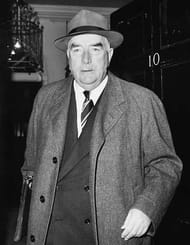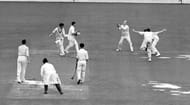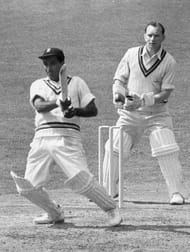The focus of the entire cricketing world was on the recently-conducted auction for the Indian Premier League (IPL). The lucrative contracts and the chance to play with the best players in the world meant that all international stars hoped to be picked up by a franchise.
Indian cricket has come a long way with the country moving from the fringes of the sport to now being one of the major stakeholders in cricket. The incentive of an IPL contract and fame, along with lucrative brand endorsements, mean that players look forward to touring India and performing well for their national sides.
However, touring India wasn’t the priority in the past and teams would often look to avoid visiting the country, usually because of lack of infrastructure and competitiveness of the Indian team.
The Australian team is in India for the upcoming Test series and the team management knows the importance of the Border-Gavaskar Trophy over the T20I series at home against Sri Lanka where they fielded a second-string team.
In the build-up to the series, we look at Australia's first tour to India more than 60 years ago in 1956, and some of the key talking points from that series.
#1 Political pressure resulted in planning of the tour

In the early years of Test cricket, Australia were hesitant in helping out newer teams, and restricted their tours to mainly England and South Africa. While India had toured Australia in 1947 after the country received its independence, the Aussies hadn’t reciprocated and were reluctant to tour the Indian sub-continent.
But with Australia’s foreign policy of closely helping the developing nations in the Commonwealth, Prime Minister Robert Menzies was keen on conducting a cricket tour of the Commonwealth nations – looking to use cricket as a medium to increase the diplomatic and financial influence of Australia.
After the Australian cricket board (called Australian Cricket Board for International Cricket back then) rejected a tour invitation by India in 1953, Menzies wrote to the board and used his influence get them to rethink their foreign tour policy.
The prime minister played a key role in getting the team to make their first tour of the West Indies in 1955. He also got a trip to Pakistan and India planned after the 1956 Ashes in England, and the team made a stop in Asia after the England tour before heading home.
#2 Tired Australian players surprised everyone by winning the series 2-0
While the tour to India would have pleased the Australian Prime Minister, it was far from ideal for the Aussie players. Tired after a long tour of England in which they lost the Ashes (Jim Laker took 19 wickets in the fourth Test), the side went to Karachi only to be brutally beaten by Pakistan by nine wickets.
The players had to then visit India for a three-match series and weren’t expected do well against an Indian side that had defeated New Zealand at home earlier in the year. The retirement of Keith Miller would have lowered the morale of the visitors as they faced off against a strong Indian team.
However, the Australians were able to raise their game in the series and won 2-0, with captain Ian Johnson’s knock of 73 at number 9 in the first Test setting the foundation for the team’s successful tour.
A series victory in India will often feature as a landmark moment in the careers of the players. But the homesick players were only too glad to head back to Australia on the completion of the series, and their memoirs have negligible mention of the 1956 tour to India.
#3 Emergence of Richie Benaud as a star
While talking about the series, Ray Lindwall mentioned the lack of bowling options in the Australian side because of injuries. One player who took advantage of the situation was all-rounder Richie Benaud, as he tweaked his bowling style. This resulted in him being converted from a handy bowling option to the team’s main bowler.
Heat and humidity in the Karachi game had prompted him to reduce his bowling run-up and change the run-up from a straight run to an angular run. He employed that in the India series as well and was immensely successful as he picked up a seven-wicket haul in India’s first innings in the first match at Madras.
Benaud finished the series with 23 wickets and announced his arrival as a star in world cricket. He went on to play a major role in Australia’s success in the following years with both bat and ball and was given the Test captaincy in the 1958-59 season.
The player had taken 50 wickets from 24 Tests before the 1956 India series at an average of 34, and his bowling record in Test cricket post the change in action read 198 wickets from 39 matches at slightly over 25.
#4 Gulabrai Ramchand’s century helped India avoid an embarrassing whitewash
The strong Indian batting which had the likes of Polly Umrigar, Vinoo Mankad, Vijay Manjrekar and Pankaj Roy was unable to impress against an Australian attack spearheaded by Benaud. A major reason for the team’s 0-2 defeat in the series is because of the failure of the team’s batting.
With defeats in the first game at Madras and third game at Calcutta, the hosts avoided an embarrassing whitewash because of the draw in the second match at Mumbai. With captain Umrigar opting to bat first at Brabourne Stadium, the hosts found themselves in a spot of bother with the loss of early wickets.
A brilliant innings of 109 by Gulabrai Ramchand helped India to a respectable total of 251 (their highest in the series). With the visitors responding with a huge total of 523-7 in their innings (centuries from Jim Burke and Neil Harvey), Ramchand’s knock gained more significance as it meant that India wasn’t totally outplayed in the game.
The home team continued its resistance in the second innings with fighting half-centuries from Roy and Umrigar salvaging a draw.
#5 Colin McDonald’s unique record
Unlike the Australian tours to India in the 21st century which capture the attention of the entire cricket world, the 1956 series was a low key event and with the exception of Richie Benaud, there weren’t too many talking points. As the articulate Benaud himself wrote, “This 1956 series in India, consisting of only three Tests, produced remarkably little attractive cricket.”
There is, however, an interesting anecdote from the series – a record which may not be broken in cricket any time in the near future. Colin McDonald, while facing the first delivery of Australia’s innings (off Gulabrai Ramchand) in the first Test, became the first batsman to face the first ball bowled to a country’s player in three different countries – having faced Australia’s first ball in West Indies and Pakistan as well.
With the likelihood of new teams achieving Test status unlikely in the near future, it is possible that McDonald’s unique feat will be secure for a long time.
Follow IPL Auction 2025 Live Updates, News & Biddings at Sportskeeda. Get the fastest updates on Mega-Auction and cricket news



